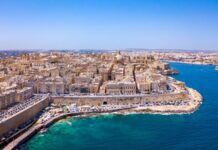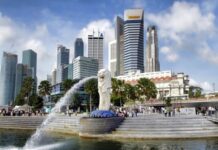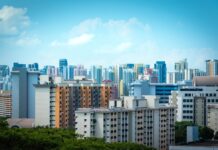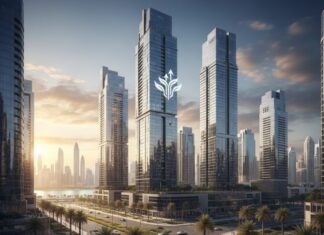
Dubai’s property market has surged in recent years, drawing interest from both families and long-term investors.
Rapid infrastructure expansion, tax-free returns, and community-focused planning contribute to sustained interest.
Those aiming for future-proof value now look to neighborhoods that promise livability along with consistent financial returns.
Areas with solid transport links, top-rated schools, and well-planned amenities are now in focus, especially those with long-term government backing.
1. Jumeirah Village Circle (JVC)
Jumeirah Village Circle ranks among the most preferred areas for both families and first-time investors.
With an average rental yield hovering around 8.6%, it delivers solid returns while remaining accessible for newcomers to the market. A balanced mix of villas, townhouses, and apartments allows flexibility for different income brackets.
Designed with community living in mind, JVC offers parks, schools, supermarkets, and fitness centers all within walking distance. Affordability, combined with lifestyle appeal, attracts young professionals, mid-income families, and long-term renters.
Key features:
- Average rental yield: ~8.6%
- Family-friendly with community parks and schools
- Wide property selection: villas, townhouses, and apartments
- High tenant demand among young families
JVC’s relatively low property prices and steady infrastructure development contribute to continued investor interest.
For those working with a real estate agency in Dubai, this area often appears on shortlists due to strong returns and livability.
2. Dubai Hills Estate
Dubai Hills Estate represents a premium, master-planned suburb that blends luxury with practicality.
With its central park, 18-hole championship golf course, Dubai Hills Mall, and multiple schools, it creates a self-sufficient environment for families.
Long-term capital appreciation in this area is driven by both high-quality development and consistent demand.
Investors find value in its upscale positioning, while end-users are drawn to spacious villas, modern apartments, and the suburban feel not far from the city core.
Key features:
- Integrated development: parks, malls, schools, and golf course
- High potential for capital appreciation
- Preferred by high-income families and expats
- Good balance of lifestyle and rental yield
Proximity to Downtown Dubai and well-maintained green spaces ensures sustained interest among residents and buyers alike. It’s a strong contender for investors with a long-term outlook.
3. Dubai South
Dubai South, anchored by Al Maktoum International Airport and legacy developments from Expo 2020, is positioned for future infrastructure-driven growth.
Affordability and proximity to logistics hubs make it attractive for strategic long-term investment.
Plans for schools, parks, shopping districts, and business hubs are already underway, making it a future-ready neighborhood with potential for capital gains and rental income.
Key features:
- Future home of the world’s largest airport
- Expo 2020 legacy infrastructure in place
- Affordable entry prices
- Long-term capital appreciation potential
Investors focused on forward-looking projects see Dubai South as an area that may deliver both yield and long-term value.
Its smart planning and strategic location place it on the radar of seasoned real estate professionals.
4. Arjan (Dubailand)
Arjan in Dubailand offers budget-conscious buyers and renters a practical option.
Known for moderate property prices and a growing tenant pool, it generates average rental yields of around 6%. Surrounded by educational institutions, healthcare facilities, and entertainment spots like Miracle Garden, Arjan’s appeal is rising fast.
Rapid development and access to major roads like Umm Suqeim and Sheikh Mohammed Bin Zayed Road enhance accessibility.
Key features:
- Approximate rental yield: ~6%
- Home to Miracle Garden and Butterfly Garden
- Easy road access and close to schools
- Strong demand among young families
Smart investors target Arjan for its balance of affordability and upward mobility. It’s a neighborhood gaining attention as infrastructure projects unfold around it.
5. Al Furjan
Al Furjan is designed with family living at its core. Spacious villas, cozy apartments, and excellent public facilities have earned it a reputation among mid-income families.
With an ROI of around 8%, it’s a preferred choice for investors seeking consistent returns.
Metro access, well-planned streets, and community clubs further contribute to livability. Buyers benefit from both capital growth potential and rental demand fueled by nearby employment zones like Jebel Ali and Dubai Investment Park.
Key features:
- Rental yield: ~8%
- Community feel with retail centers and mosques
- Close to metro and key employment areas
- Suitable for end-users and long-term investors
Family-friendly planning and good connectivity combine to make Al Furjan a consistent performer in Dubai’s property market.
6. Town Square Dubai
Town Square Dubai represents affordable, master-planned suburban living with strong investor interest.
Projects by NSHAMA ensure community amenities are thoughtfully integrated. The area delivers high projected returns near 7.9%, attracting both investors and end-users.
It includes schools, parks, fitness areas, and retail outlets, all built to accommodate young families. Ongoing projects keep improving the area’s outlook.
Key features:
- Projected ROI: ~7.9%
- Affordable pricing for villas and apartments
- Community-focused infrastructure
- Increasing tenant and buyer interest
For those prioritizing family lifestyle with budget-conscious planning, Town Square offers a compelling mix of community and financial growth potential.
The Bottom Line
Dubai remains a powerful option for families seeking quality living and investors targeting consistent returns.
Suburban-style, master-planned communities dominate due to livability, affordability, and projected growth.
Real estate decisions should be based on infrastructure investment, government planning, and current tenant demand.
Families and investors alike benefit by selecting areas built for long-term stability and financial performance.














